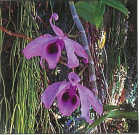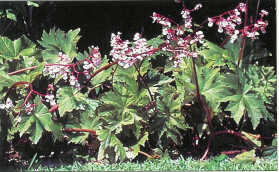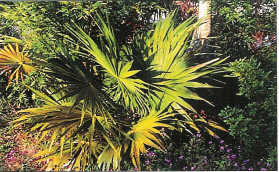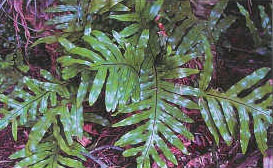And Not A Drop
Chuck Hubbuch, Former Director of Plant Collections
photos by the author
 |
| Dendrobium superbum flowers best during a dry season. |
Once again, we are suffering from a drought. Although South Florida received ample rain last year, the area that drains into Lake Okeechobee did not. Lake Okeechobee is the primary source of water for the aquifer that supplies our drinking water. Now, South Florida residents are restricting their water use and trying to protect their plant collections. Fairchild Tropical Garden is reducing its water use as well. We hope our example will be useful for area homeowners.
 |
| Begonias look fragile, but actually tolerate drought well. |
Drought is natural. As the area's human population grows, droughts will have an ever-increasing effect on our daily lives. I am sure you have already heard many ways of conserving water: turn off the water while you are brushing your teeth, check your household for leaks and so forth. Also keep in mind that today's landscape decisions will determine whefuer or not you are ready for the next drought.
 |
| Thrinax radiata is an attractive palm for dry shade. |
Planting only drought tolerant plants is one approach. The problem that I have experienced with this approach is that the plants most tolerant to drought are also prone to rotting during heavy summer rains unless you modify your planting site. This means it may take a little experimentation to find which plants tolerate both winter drought and an abundance of rain in the summer. Native plants, especially hammock and pineland species, are good plants to start with. In general, the problem with many avid gardeners is that they just have to possess certain plants. Whether or not these plants are well-suited to cultivation in South Florida is not one of their criteria.
 |
| Aechmea ‘Bert’ is one of many drought tolerant bromeliads. |
The single best protection against drought is a shady yard. On a sunny spring day, solar radiation evaporates water from pools and the soil at an incredible rate. Mulch helps reduce evaporation from soil. Shade trees help even more. To maintain a lawn, use trees with open canopies or small leaves. Native trees, such as oaks and wild tamarinds, are reliable choices. Large trees can be trimmed to create open canopies, thus providing more light for the grass and preparing for hurricane season at the same time. Because a grassy lawn in shade does not tolerate heavy foot traffic, you'll want to create some formal paths in a shady landscape. Better yet, use drought and shade tolerant ground covers like wart ferns, dwarf oyster plants, rhizomatous begonias pentas and compact philodendrons.
 |
| Polypodium scolopendrium makes a great ground cover. |
Once your landscape is shaded, dry winter winds will be your biggest problem. While you will not want to block summer breezes, you should plant a screen of shrubs on the north side of your property to reduce the drying effect of winter winds. Shrubs on the west side will help create protected pockets, but do not plant so heavily that you block afternoon breezes in the summer. Leave the east and south sides of your property open to breezes.
Native plants from Florida's rocky woodlands and the coast are among the best suited plants for unirrigated landscapes. If the native look doesn't suit you, use native and other drought tolerant trees and large shrubs to build the framework of your landscape, then create a tropical look in the shade of these trees. The key is to get the plants established by planting them during the early part of the rainy season. Water as needed during the summer while they root into their new home. Then hand water when necessary during their first winter. Finally, turn them over to nature. In my opinion, my home garden is there to serve me, not the other way around.
If you investigate diligently, you may be surprised at the wide range of plants that grow in South Florida without supplemental irrigation. Here are a few that provide a bold, tropical look in shade.
Palms
- Chamaedorea cataractarum (cat palm)
- Chamaedorea metallica
- Chamaedorea seifrizii (bamboo palm)
- Chamaedorea stolonifera
- Livistona rotundifolia (foot stool palm)
- Ptychosperma species* (solitaire, MacArthur and others)
- Sabal minor (in bright shade)
- Thrinax radiata* (thatch palm)
Ferns
- Nephrolepis species (Boston fern)
- Platycerium bifurcatum (staghorn fern) (epiphyte)
- Polypodium scolopendria (wart fern)
Cycads
- Dioon spinulosum and D. mejiae
- Ceratozamia kuesteriana and relatives
- Zamia vasquezii and its Mexican relatives
- Zamia pumila and its Florida and Caribbean relatives
Bromeliads
- Aechmea rubens and relatives
- Neoregelia species and hybrids
- Portea petropolitana
- Puya atpestris
 |
| Chuck Hubbach |
Orchids
- Brassavola nodosa
- Cattleya skinneri and hybrids
- Encyclia cochleata (shell orchid)
- Encyclia tampensis
- Schomburgkia tibicinus
Aroids
- Aglaonema species (Chinese evergreen) and relatives
- Anthurium salviniae and other bird's nest anthuriums
- Monstera deliciosa (monstera)
- Philodendron gigantea
- Philodendron imbe (philodendron 'Burle Marx')
Begonias
- Begonia heracleifolia (winter begonia)
- Begonia popenoei
- Begonia ricinifolia (castor bean begonia)
Heliconias and gingers
- Aipinia zerumbet (shampoo ginger) (dies down in winter)
- Costus scaber
- Heliconia episcopalis
- Heliconia latispatha
- Heliconia rostrata
Miscellaneous
- Ardisia escallonioides (marlberry)
- Clerodendrum thomsoniae (glory bower vine) (flowers in shade)
- Peperomia obtusifolia
- Rhipsalis baccifera (mistletoe cactus) (epiphyte)
- Rhoeo spathacea (use the dwarf variety only, which does not spread by seeds)
For More Information
More information on the water restrictions can be found on the South Florida Water Management District's (SFWMD) website.
Garden Views May 2001